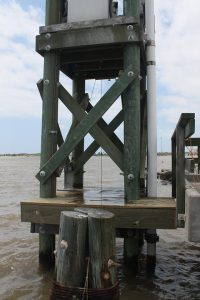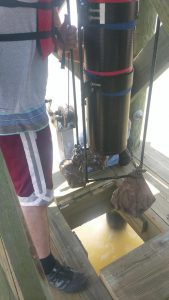 NCCOS-funded investigators from Texas A&M University (TAMU) successfully deployed an Imaging Flow Cytobot (IFCB) on a pier near Freeport, Texas. This is the second cytobot deployed in the Gulf of Mexico as part of an expanding cytobot network to provide early warning of harmful algal blooms (HABs) that impact coastal resources. Blooms of Karenia brevis, the organism responsible for red tide in the Gulf of Mexico, can impact the health of humans and animals.
NCCOS-funded investigators from Texas A&M University (TAMU) successfully deployed an Imaging Flow Cytobot (IFCB) on a pier near Freeport, Texas. This is the second cytobot deployed in the Gulf of Mexico as part of an expanding cytobot network to provide early warning of harmful algal blooms (HABs) that impact coastal resources. Blooms of Karenia brevis, the organism responsible for red tide in the Gulf of Mexico, can impact the health of humans and animals.
The IFCB uses a laser-based system to detect algae and takes microscope photographs for species identification in real time. This automated underwater microscope enables continuous monitoring of algal communities and alerts managers to rising levels of toxic algae. Alerts from a cytobot in Port Aransas, Texas, also operated by TAMU, have triggered more intensive algal bloom monitoring of the bay-complex near Corpus Christi. The Texas Parks and Wildlife Department and the Texas Department of State Health Services use these alerts to ensure harvested shellfish are safe to eat, beach experiences are enjoyable, and to investigate marine wildlife die-offs. NOAA also includes IFCB data in HAB bulletins for Texas.

The new IFCB is deployed on a NOAA-owned platform on a pier at U.S. Coast Guard (USCG) Station Freeport (Surfside Beach, Texas). Data can be viewed here. The TAMU-led research team is working to add the new data stream to a network that will automate availability of algal cell counts. The team has also confirmed the Freeport location is suitable for HAB alerts that will protect coastal bays from Freeport to Galveston. Fully implemented, the Texas IFCB network can be scaled-up to expand alerts to other Gulf of Mexico states.
This effort is funded through the NCCOS Prevention, Control, and Mitigation of Harmful Algal Blooms Program. Key NCCOS partners supporting this deployment include USCG Station Freeport, the NOAA Center for Operational Oceanographic Products and Services, and the Gulf of Mexico Coastal Ocean Observing System.
For more information, contact Marc.Suddleson@noaa.gov.
